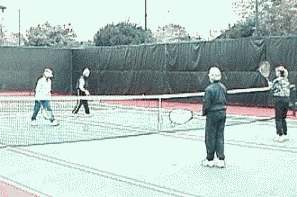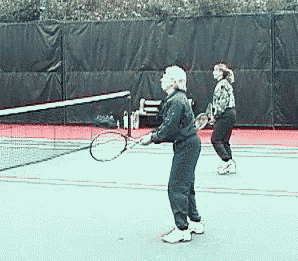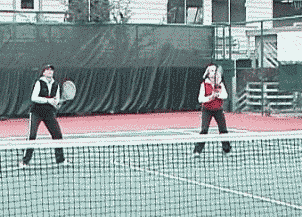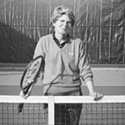|
TennisOne Lessons Coaching, Teaching..And Winning By Pat Blaskower
To coach or to teach? That is the essential question because the two are markedly different from each other. Nothing is more frustrating for a budding competitor in desperate need of a winning attitude than to be spending court time and money on a topspin forehand that won't mature for two years and most certainly couldn't be integrated into a fearful player's repertoire under any circumstances. Not every player needs every shot in the book, nor can every player master all the possibilities. I try to teach my players those strokes necessary for success on the singles court if that is their preference, and teach my doubles players only those weapons they will need to compete well. I try to work largely with what they already possess, tweaking things when appropriate and emphasizing court position. Most of my students are employed men and women with families who chose to spend their leisure time seriously competing on the tennis court. A generic overhaul of their games, insisting, for instance, that they eschew that slice for a topspin backhand, would be a fruitless and self-defeating endeavor. I try to divide the time I spend teaching and the time I spend coaching by season. In September, I begin teaching those strokes and shots I have observed my summer teams executing poorly. We spend entire clinics working on angled volleys, drop shots, spin serves and moving directly to the net behind serves and service returns in doubles. I make no exceptions for the level of play I am teaching, insisting that my 3.0 players serve and volley as well as my 4.5 teams. All are required to execute drop shots and angled volleys. In March, I stop teaching and begin coaching. USTA league play starts in May, and it is ridiculous to continue to work on generalized stroke production as match play is about to begin because students won't execute new shots under pressure and you will find you are wasting precious court time on irrelevant issues when you should be focusing on teaching your students how to win. This is important, because essentially, that is what they want to do.
How to win and how to play better are fundamentally separate disciplines. If they can't execute a spin serve perfectly in March, they most definitely will not do it May. As I begin the coaching phase, I stop demanding perfect execution and focus on match management. My students start to relax a bit, knowing that at this point, I take a page from Al Davis, owner of the Oakland Raiders, and tell them to "just win, baby." We go with what we have, and rather than insist, for example, that they get to the net behind the serve, I try to offer suggestions for winning the point when pinned on the baseline. I insist, however, on absolute preparedness for the match, and that begins with the warm-up. When preparing my teams for league play, I try to impress upon them that too often it is a small oversight that can make the difference in a match. One of the most neglected areas of preparation is the warm-up gainst your opponent. I tell my players that the match starts the minute you take the court and that the first task they must accomplish is winning the warm-up. Sandy and Lisa My teams warm up amongst themselves at least an hour before the match is called,
so they always arrive prepared to play, and they understand that play begins the
moment their names are called to take the court. The ritual of their match
warm-up against their adversaries is a carefully orchestrated and
well-constructed dance designed to intimidate the opponent and establish
dominance from the moment the can of balls is opened to the last point of the
match. Nothing would bring a smile to the faces of one of my doubles teams more
quickly than the following scenario:
"I'm over here, Amy," says Judy, frantically trying to tie her much-too-long shoelaces. "Oh, good! I hear we're partners today," cries Judy. "Yes," smiles Amy. We've never played together before. This should be fun." It will, indeed, be fun - for Sandy and Lisa, not Judy and Amy. As the match is
called and the four players descend the stairs to the court, my players are
treated to the following exchange: "Oh, I don't care, Judy.do you want backhand?" "Ok, but I'm a lefty..." "Oh, should we have both backhands in the middle, then?" "Does that matter?" "Should I serve first if I'm a lefty?" "Yes, Judy. Good idea. Or maybe we should let them serve?" Sandy and Lisa, who have played together continuously for six months and who have known for two weeks that they will be in the lineup on this day, know that Sandy plays the ad court and Lisa the deuce court, and that Lisa always serves first. They arrive on the court and turn their attention to winning the warm-up while Amy and Judy prepare to discover who they are, how they play together and whether they are compatible on the court. The Victorious Warm-Up Being victorious in the warm-up is a way of taking control of the match and determining the pace, tempo and rhythm of all subsequent developments within the contest. It is also a very calming influence on my players because it is a set and unvaried routine so familiar to them that it takes no effort or concentration to perform, leaving their minds free to assess the strengths and weaknesses across the net.
After the niceties, smile sweetly and ask "Shall we spin now?" As you are
spinning your racquet. (In a District match, one of my teams asked "Shall we
spin?," and paused for the reply, only to be told "No." From then on, I told
them to spin as they ask.) The importance of spinning first will become evident
later. If you win the spin, it is far less important that you serve first than
that you know in advance what you want to do and don't hesitate about it.
Remember, there is no other time the server is more likely to lose his serve
than in the first game of the match, so receiving first is really a viable
option. If your presence at the net is viewed by your opponents as an invitation for cooperative "short court" mini tennis, rebuff it politely with some protestation that you are just no good at "short court." The last thing you need is to make a new best friend of your adversary by hitting gently to him across the net when you are supposed to be dissecting his fatal flaws. Don't leave the net without taking your overhead practice, together, as a team. Having done so, leave the net together and allow your opponents to practice volleys and overheads. If they choose not to, so much the better, and you should view this as a certain indication that they do not intend to play "serve and volley" tennis. Watch the clock and control it. If there are only three minutes left in your ten minute warm-up and your opponents are still dallying at the net, politely inquire if they are ready for serves. In some areas of the country matches are timed, and you don't want to waste precious match time warming-up.
When it is time for taking serves, you will see the importance of having spun the racquet before you take the court rather than after the warm-up is completed. If you are the team serving first, make sure the partner who is going to serve first takes his practice serves from the ad court and finishes in the deuce court - the court he will serve to momentarily. If you are going to receive first, make sure the player who plays the ad court takes his first serves in the deuce court and finishes in the ad court. That way, you both have an opportunity to throw in some practice returns of serve from "your" side of the court when you are finished warming up your serve. If your opponents are busy whacking all of your serves back at you without taking their own opportunity to serve, ignore it. Time may run out before they decide to practice serving. Never play "out" balls in the warm-up. Never chase balls out of your reach or
make a diving attempt to get to a ball on one bounce. Present an aura of calm
and of unflappable confidence. Should your opponent think that winning the
warm-up is about smashing balls to the farthest corners of the court, always
impossibly out of your reach, don't get flustered. Doubles partners can switch
with each other halfway through the ten minutes, and singles players can rejoice
in the fact that they have warmed up previously with a teammate and it is the
animal across the net who is wasting his own precious warm-up time. Your comments are welcome. Let us know what you think about Pat Blaskower's article by emailing us here at TennisOne.
|






